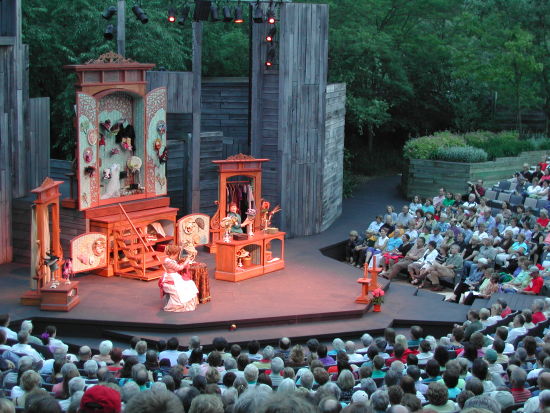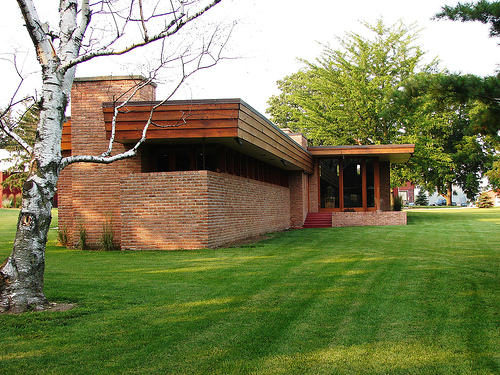“I don’t think in any language. I think in images. I don’t believe that people think in languages. They don’t move their lips when they think. It is only a certain type of illiterate person who moves his lips as he reads or ruminates. No, I think in images, and now and then a Russian phrase or an English phrase will form with the foam of the brainwave, but that’s about all.”
Vladimir Nabokov, Strong Opinions
Archives for 2009
THE CRAFTY ART OF ALAN AYCKBOURN
“Could it be that Ayckbourn is ‘the Chekhov of our time,’ as Matthew Warchus, the director of the Old Vic revival of The Norman Conquests, has claimed? At the very least, I believe he is not a commercial playwright but a kind of poet, a craftsman of genius who never lets you forget for a moment that his often ludicrous characters, like Chekhov’s, are trapped in a world that has failed to live up to their expectations…”
OGIC: Some links
Hi there, I’m just back from a largely internet-free vacation (except for some road tweeting) and am pretty busy catching up on everything, including my blog reading. Here are some items that have made me a little bit less sad to be back from perch dinners and rockhounding.
● At A Commonplace Blog, D. G. Myers reviews the new Richard Russo novel That Old Cape Magic and includes Russo’s Empire Falls in his best American novels of the first decade of the twenty-first century. Find out his other four here.
● Levi Stahl is reading Anthony Powell again. He has some especially nice observations here.
● Finally, the Walrus reminds us that before there was texting, there was passing notes in class. What’s been lost in the transition? Penmanship as an added means of expression, certainly–“I am attempting to write neater this time so I won’t give away my frenzied state of mind,” one of the reprinted notes reads–and the happy fact that these snapshots of Saskatchewan school life around 1960 survived at all.
Enjoy, and eat cherries.
TT: Almanac
“New York: Prison towers and modern posters for soap and whiskey.”
Frank Lloyd Wright (quoted in the New York Times, Nov. 27, 1955)
CAAF: Holy moly*
Maud directs the way to this essay by Anne Carson about the “metaphysical silences” of translations — places where the text falls silent, not because it’s incomplete, but because in some larger sense there are no words. As illustration, Carson uses a passage from The Odyssey and, even more interestingly, the transcripts from Joan of Arc’s trial. It’s good stuff.
The essay sent me back to If Not, Winter, Carson’s translations of the fragments of Sappho, although there, as Carson notes, the silences are physical, not metaphysical. She writes: “Physical silence happens when you are looking at, say, a poem of Sappho’s inscribed on a papyrus from two thousand years ago that has been torn in half. Half the poem is empty space. A translator can signify or even rectify this lack of text in various ways–with blankness or brackets or textual conjecture–and she is justified in doing so because Sappho did not intend that part of the poem to fall silent.”
I wish we had the poems; but I love the fragments too. And the silences around them, as rendered by Carson, take on their own kind of beauty. Here are a few examples:
25
]
] quit
]
] luxurious woman
]
]
]
36
I long and seek after
42
their heart grew cold
they let their wings down
103
]yes tell
]the bride with beautiful feet
]child of Kronos with violets in her lap
]setting aside anger the one with violets in her lap
]pure Graces and Pierian Muses
]whenever songs, the mind
]listening to a clear song
]bridegroom
]her hair playing the lyre
]Dawn with gold sandals
* See the essay. I like to think this was Carson’s working title.
TT: Almanac
“The screech and mechanical uproar of the big city turns the citified head, fills citified ears–as the song of birds, wind in the trees, animal cries, or as the voices and songs of his loved ones once filled his heart. He is sidewalk-happy.”
Frank Lloyd Wright, The Living City
TT: Y’all don’t cut down that cherry tree!
In today’s Wall Street Journal drama column, I report on a recent visit to the Los Angeles area, where I saw the Will Geer Theatricum Botanicum‘s production of a modernized adaptation of The Cherry Orchard, which is currently being performed in repertory (along with five other classic plays) in the company’s woodsy outdoor amphitheater. I liked it very much, a couple of quibbles notwithstanding. Here’s an excerpt.
* * *
Whenever I hear about a new staging of a Shakespeare play, my first question is, “Where’s it set?” Contemporary production style all but demands that the action of Shakespeare’s plays be moved to a different time and place–but the language is never changed accordingly. On the other hand, it’s become equally common for the plays of Anton Chekhov and Henrik Ibsen to be performed in up-to-date English-language “adaptations” that depart widely from the original Russian and Norwegian texts–but the period settings are almost always retained. Now the Will Geer Theatricum Botanicum has split the difference with a biracial rewrite of Chekhov’s “The Cherry Orchard” set in Virginia in 1970. Does it work? Most of the time, and even when it doesn’t quite come off, it’s still worth seeing.
In this version, written by Heidi Helen Davis (who also directs) and Ellen Geer, the Ranevskayas, Chekhov’s impecunious Russian aristocrats, become the Randolphs, a cash-poor upper-class family from Charlottesville whose plantation estate is about to go on the block. Not only are their servants black, but so is Lawrence Poole (Steve Matt), the American counterpart of Lopakin, the ex-serf turned status-hungry businessman who buys the Ranevskaya estate and chops down its beloved cherry orchard at play’s end. This transposition gives the Davis-Geer adaptation a sharp-edged racial angle that is its most telling feature, in part because it arises so naturally from Chekhov’s original play….
* * *
Read the whole thing here.
TT: Points west
 Mrs. T and I hit the road today. Our final destination is Spring Green, Wisconsin, where we’ll be seeing American Players Theatre perform two plays by Shakespeare, one by George Bernard Shaw, and one by Eugene O’Neill. That’s a lot of theater to consume in a single weekend, and it also entails a lot of driving–we’ll be flying into Chicago this afternoon, renting a car, and driving north to Wisconsin. I’d be skeptical about pouring so much time and energy into a single reviewing trip were it not for the fact that my previous visits to American Players Theatre have been enormously satisfying. I have similarly high hopes for this one.
Mrs. T and I hit the road today. Our final destination is Spring Green, Wisconsin, where we’ll be seeing American Players Theatre perform two plays by Shakespeare, one by George Bernard Shaw, and one by Eugene O’Neill. That’s a lot of theater to consume in a single weekend, and it also entails a lot of driving–we’ll be flying into Chicago this afternoon, renting a car, and driving north to Wisconsin. I’d be skeptical about pouring so much time and energy into a single reviewing trip were it not for the fact that my previous visits to American Players Theatre have been enormously satisfying. I have similarly high hopes for this one.
 On the way back home, we’ll be spending a night at Muirhead Farmhouse, the only Frank Lloyd Wright house (so far as I know) that is currently being operated as a bed-and-breakfast. It’s just far away enough from O’Hare Airport to serve as a convenient stop for travelers en route between Spring Green and Chicago, and our last visit there was so pleasing that we decided to go back this year.
On the way back home, we’ll be spending a night at Muirhead Farmhouse, the only Frank Lloyd Wright house (so far as I know) that is currently being operated as a bed-and-breakfast. It’s just far away enough from O’Hare Airport to serve as a convenient stop for travelers en route between Spring Green and Chicago, and our last visit there was so pleasing that we decided to go back this year.
We won’t return to Connecticut until Tuesday night, so don’t expect to hear from me again before Wednesday or Thursday (though I might surprise you). I trust that Our Girl and CAAF will keep you properly amused while I’m out and about.
